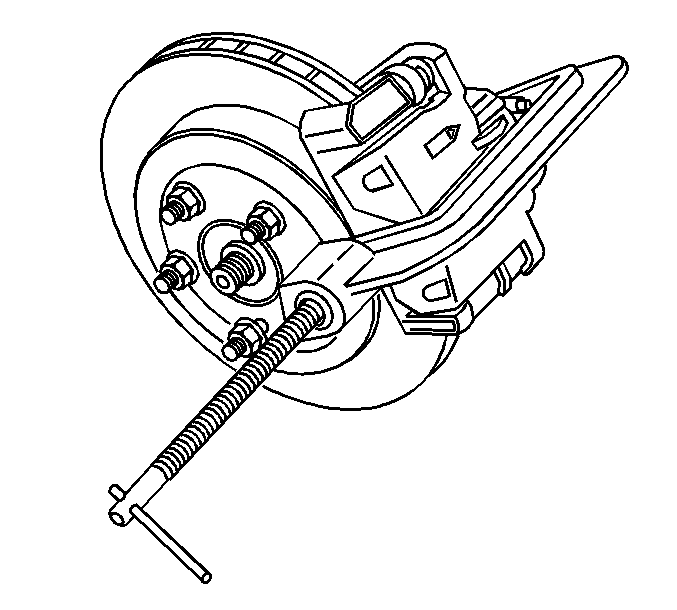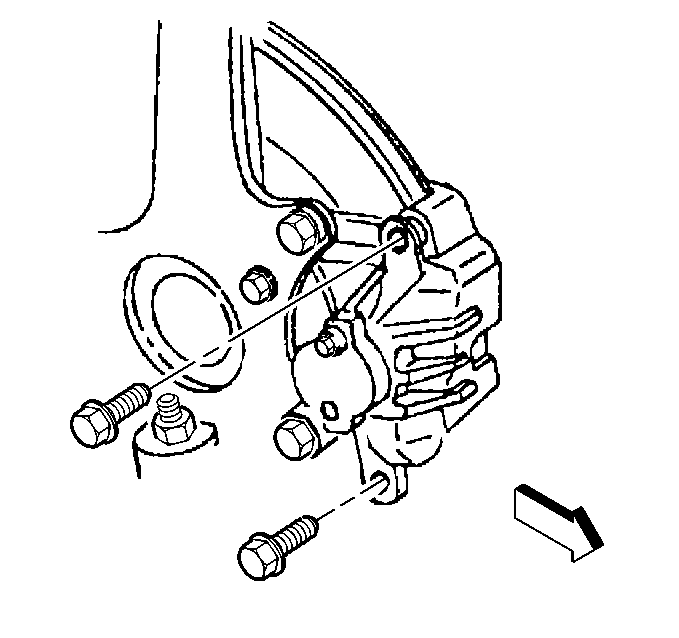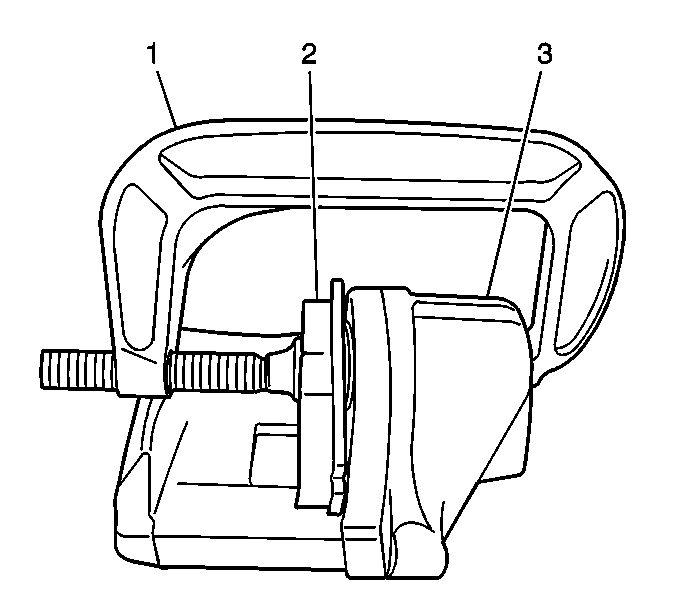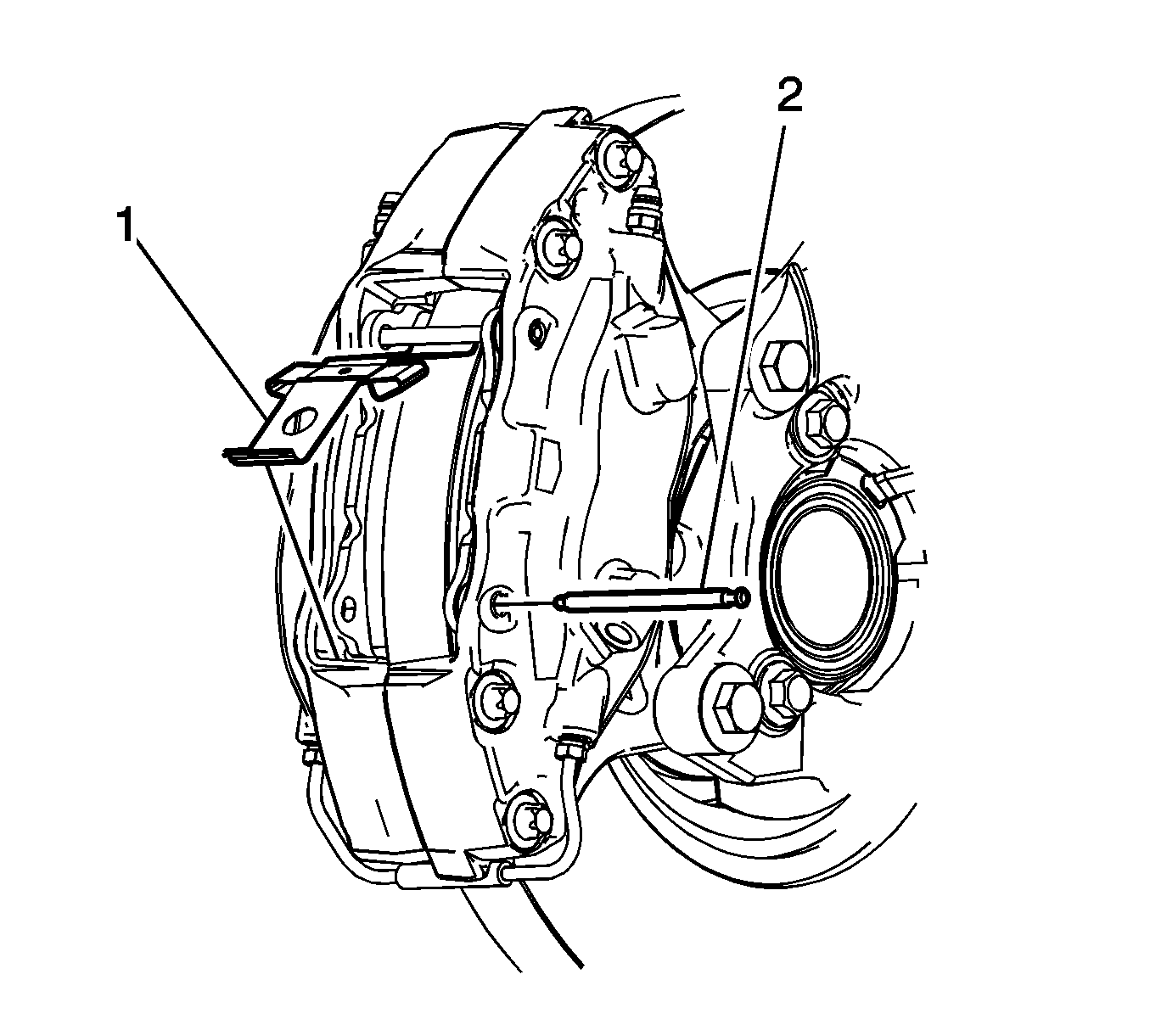Rear Disc Brake Pads Replacement JE5, JL9
Warning: Refer to Brake Dust Warning in the Preface section.
Removal Procedure
- Inspect the fluid level in the brake master cylinder reservoir.
- If the brake fluid level is midway between the maximum-full point and the minimum allowable level, no brake fluid needs to be removed from the reservoir before proceeding.
- If the brake fluid level is higher than midway between the maximum full point and the minimum allowable level, remove brake fluid to the midway point before proceeding.
- Raise and suitably support the vehicle. Refer to Lifting and Jacking the Vehicle.
- Remove the tire and wheel assembly. Refer to Tire and Wheel Removal and Installation.
- Install a large C-clamp over the body of the brake caliper with the C-clamp ends against the rear of the caliper body and against the outboard brake pad.
- Tighten the C-clamp until the caliper piston is compressed into the caliper bore enough to allow the caliper to slide past the brake rotor.
- Remove the C-clamp from the caliper.
- To loosen the brake caliper lower pin bolt, hold the brake caliper guide pin with a wrench.
- Loosen the lower brake caliper pin bolt and remove the lower brake caliper pin bolt.
- Pivot the brake caliper upward from the caliper bracket and support the caliper out of the way with heavy mechanic's wire or equivalent; ensure that there is no tension on the hydraulic brake flexible hose. Do NOT disconnect the hydraulic brake flexible hose from the caliper.
- Remove the brake pads from the caliper bracket.
- Remove and inspect the brake pad retainers from the caliper bracket.


Caution: Support the brake caliper with heavy mechanic wire, or equivalent, whenever it is separated from its mount and the hydraulic flexible brake hose is still connected. Failure to support the caliper in this manner will cause the flexible brake hose to bear the weight of the caliper, which may cause damage to the brake hose and in turn may cause a brake fluid leak.
Installation Procedure
- Inspect the brake caliper guide pin bolts. If damaged or corroded replace the brake caliper guide bolts.
- Inspect the brake caliper guide pins. If damaged, or corroded replace the brake caliper guide pin. Do not attempt to clean away any corrosion. Refer to Rear Disc Brake Hardware Replacement.
- Inspect the brake caliper guide pin seals for cuts, tears, or deterioration. If damaged, replace the brake caliper guide pin seals. Refer to Rear Disc Brake Hardware Replacement.
- Inspect the brake caliper piston boot for deterioration, replace if damaged. Refer to Rear Brake Caliper Overhaul.
- Install a large C-clamp (1) over the body of the brake caliper (3) with the C-clamp ends against the rear of the caliper body and against an old inboard brake pad (2) or a wood block installed against the caliper piston.
- Tighten the C-clamp (1) until the caliper piston is compressed completely into the caliper bore.
- Remove the C-clamp and the old brake pad or wood block from the caliper.
- Install the brake pad retainers to the caliper bracket.
- Install the brake pads to the caliper bracket. The brake pad wear sensor, mounted on the inboard brake pad, must be positioned so that it is in the trailing position during forward rotation of the brake rotor.
- Pivot the brake caliper downward, over the brake pads and into the caliper bracket.
- Prepare the bolt and the threaded hole for assembly:
- Apply threadlocker GM P/N 12345493 (Canadian P/N 10953488), or equivalent to two-thirds of the threaded length of the lower caliper pin bolt. Ensure that there are no gaps in the threadlocker along the length of the filled area of the bolt.
- Allow the threadlocker to cure approximately 10 minutes before installation.
- Apply a thin coat of high temperature silicone lube to the front brake caliper guide pin.
- Install the lower brake caliper pin bolt. Hold the lower caliper guide pin with a wrench and tighten the lower brake caliper pin bolt to 60 N·m (44 lb ft).
- Install the tire and wheel assembly. Refer to Tire and Wheel Removal and Installation.
- Lower the vehicle.
- With the engine OFF, gradually apply the brake pedal to approximately 2/3 of its travel distance.
- Slowly release the brake pedal.
- Wait 15 seconds, then repeat steps 18 and 19 until a firm brake pedal apply is obtained; this will properly seat the brake caliper pistons and brake pads.
- Fill the brake master cylinder reservoir to the proper level. Refer to Master Cylinder Reservoir Filling.
- Burnish the pads and rotors. Refer to Brake Pad and Rotor Burnishing.


Note: If reusing the lower caliper pin bolt, the threads of the lower caliper pin bolt and the threads of the caliper bracket mounting holes must be free of residue and debris prior to application of threadlocker in order to ensure proper adhesion and fastener retention.
| • | Thoroughly clean there residue from the fastener threads using denatured alcohol or equivalent and allow to dry. |
| • | Thoroughly clean residue from the threaded holes using denatured alcohol or equivalent and allow to dry. |
Caution: Refer to Fastener Caution in the Preface section.
Rear Disc Brake Pads Replacement J56
Removal Procedure
- Inspect the fluid level in the brake master cylinder reservoir.
- If the brake fluid level is midway between the maximum-full point and the minimum allowable level, no brake fluid needs to be removed from the reservoir before proceeding.
- Raise and support the vehicle. Refer to Lifting and Jacking the Vehicle.
- Remove the tire and wheel assembly. Refer to Tire and Wheel Removal and Installation.
- Holding the lower end of the retainer (1) down and using a hammer and punch carefully tap the lower caliper guide pin (2) inward out of the caliper.
- Carefully rotate the brake pad retainer upward.
- Remove the brake pad retainer.
- Using a hammer and punch tap the upper caliper to brake pad mounting pin (2) inward out of the caliper.
- Carefully insert a plastic flat-bladed trim tool between the rotor and inboard brake pad.
- Carefully apply pressure to the inboard brake pad until both caliper inner pistons are fully compressed into the caliper piston bores.
- Carefully insert a plastic flat-bladed trim tool between the rotor and outboard brake pad.
- Carefully apply pressure to the outboard brake pad until both caliper outer pistons are fully compressed into the bores.
- Remove the brake pads (1) from the caliper.
Warning: Refer to Brake Dust Warning in the Preface section.


Note: Use ONLY a plastic flat-bladed trim tool and/or another suitable soft tool when compressing the caliper pistons into the caliper piston bores. Never use any type of metal tool between the brake rotor and brake pads to compress the caliper pistons into the bores.
Installation Procedure
- Inspect the brake caliper guide pins. If damaged, or corroded replace the guide pin. Do not attempt to clean away any corrosion.
- Inspect the brake caliper piston boot for damage and/or deterioration, replace if damaged or deteriorated. Refer to Front Brake Caliper Overhaul.
- Install the brake pads (1) to the caliper.
- Install the upper caliper guide pin (2) through the caliper, inner and outer brake pads.
- Using a hammer and punch seat the upper guide pin to the outer caliper half. Ensure that the caliper guide pin is seated into the outer caliper pin seat.
- Install the brake pad retainer (1) under the upper caliper pin assembly.
- Rotate brake pad retainer down.
- Carefully apply pressure downward on the lower end of the brake pad retainer.
- Carefully install the lower caliper guide pin (2) through the caliper, inner and outer brake pads.
- Using a hammer and punch seat the lower guide pin to the outer caliper half. Ensure that the caliper guide pin is seated into the outer caliper pin seat. Ensure that the brake pad retainer is centered retaining both brake pads.
- Install the tire and wheel assembly. Refer to Tire and Wheel Removal and Installation.
- Lower the vehicle.
- With the engine OFF, gradually apply the brake pedal to approximately 2/3 of its travel distance.
- Slowly release the brake pedal.
- Wait 15 seconds, then repeat steps 13 and 14 until a firm brake pedal apply is obtained. This will properly seat the brake caliper pistons and brake pads.
- Fill the brake master cylinder reservoir to the proper level. Refer to Master Cylinder Reservoir Filling.
- Burnish the pads and rotors. Refer to Brake Pad and Rotor Burnishing.


